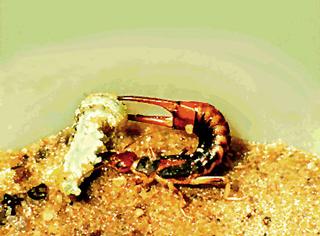
 |
 |
Order
- DERMAPTERA
(Greek, derma = skin, pteron = wing)
Common Name: earwigs
Distribution: Cosmopolitan
Description
Earwigs are elongate, often rather flattened insects with well developed
mandibles. The distinguishing characteristic of this order is the presence
of forceps at the end of the abdomen. Forceps are used by earwigs in a
threatening display when disturbed. However, they are harmless to humans
and are only capable of producing a sharp pinch. The terminal forceps may
be used to carry insect prey or may be used during mating to grasp the
partner. Earwigs may or may not possess wings. Winged species have
forewings modified into small, tough covers (the tegmina). Hind wings are
membranous, semicircular and are folded in "fan" form under the
tegmina. Hind wings can also be folded across so that the whole wing is
packed into a very small space. Compound eyes may be small, large or
absent, and simple eyes (ocelli) are always absent.
Nymph
No comparable stages to caterpillar and pupa occur in earwigs. The nymphs
emerge from the eggs and resemble miniatures of the adults. Nymphs moult
several times before reaching adult size and maturity. Earwigs display
maternal activity. The mother guards the egg clutch and young offspring
until they are able to fend for themselves.
Members
Earwigs.
Food
Most species feed on dead plant material. However, some species attack
living plants. Animal material will be eaten if available and earwigs will
readily consume dead insects as food. A few specialised earwigs are
parasites of bats and rodents.
Importance
Few earwigs are of economic importance. In Australia, the introduced
European earwig (Forficula auricularia) causes considerable damage
to orchards and garden ornamentals where it destroys both fruit and
flowers. Australia is remarkable in possessing a giant earwig, Titanolabis
colossae, which occurs in rainforest litter and can be 4-5 cm in
length. |